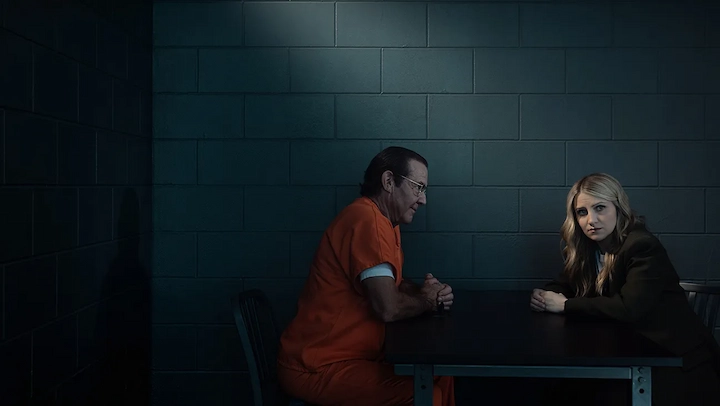Behind the Mask: The True and Fictional Chilling Story of Ennis Breeze in Happy Face
Then there’s Happy Face, which is so incredibly disturbing because it’s based in reality; it comes from the life and story of Melissa Moore, daughter of the serial killer Keith Jesperson.
Breeze is a creepy true-crime author obsessed with Jesperson’s crimes. He deepens the narrative and questions around media ethics and our fascination with murderers. This article examines Ennis Breeze’s backstory, his place in the tale, and the line between fact and fiction in the series.
It unpacks how real-life figures like Melissa Moore and Keith Jesperson shaped a creepy story that intrigues viewers. If you’re wondering how much crime shows are real and how much are dramatized, read on.
Ennis Breeze, Imaginary Friend Based On Non-Fictional Obsession
Ennis Breeze does not exist. He is a character created for Happy Face, meant to illustrate how true-crime stories draw odd fans—sometimes dangerous ones. In the series, Ennis is portrayed as a true-crime novelist who idolizes Keith Jesperson. He’s creepy, mysterious, and very much involved in the imprisoned killer’s efforts.
Ennis isn’t a real person — no one in real life is exactly like him — but aspects of his character reflect patterns observed with many actual serial killers. Also known as the “Happy Face Killer,” Keith Jesperson has been the subject of multiple books written by true crime authors.
Some have even corresponded with him in prison. These authors often pursue heartrending, exclusive details, but the show pushes that pursuit toward a more unsettling territory. Ennis doesn’t stop at writing — he performs, impeding Melissa’s existence and becoming part of Jesperson’s ghastly extended arm.
The character reflects the public and media’s real-world obsession with serial killers — something that the last few seasons of “Dexter” have alighted on. In mashing these ideas together, Happy Face makes Ennis into a symbol — he is, in his disgruntled and indignant way, an obsession designed to show the kind of dangers that can emerge from curiosity when it veers into worship.
Keith Jesperson And His Connection To The Real-Life Happy Face
Keith Hunter Jesperson is indeed very real — and very dangerous. As a truck driver, he killed a minimum of eight women between 1990 and 1995. He left behind notes signed with a smiley face that inspired his nickname: the Happy Face Killer. He is currently serving multiple life sentences in Oregon.
Jesperson’s crimes destroyed the life of his daughter, Melissa Moore. As a teenager, she discovered that her father was a killer. Her childhood—sweet and innocent at the time—acquired dark new meanings. Jesperson had expressed strange thoughts about killing when she was young.
Melissa had to confront the horrifying truth that the man her father had hidden under the surface had been hiding in plain sight. These lived experiences ground Happy Face. Some details are exaggerated — Melissa’s job on a fictional talk show for one — but the emotional weight is real.
Jesperson’s manipulation, charisma, and sadism are keynotes. Through him, the show poses the question: How do you love someone who turns out to be a monster?
From Serial Killer’s Daughter To True Crime Advocate: Melissa Moore
Melissa Moore didn’t remain silent. After the trauma of discovering her father’s crimes, she decided to go public. She wrote a memoir (Shattered Silence), started a podcast (Happy Face), and became a true crime journalist and advocate. Her goal? To advocate for victims and children of violent offenders.
In Happy Face, Melissa’s fictional double is a make-up artist whose life is upended when her jailed father begins making public allegations. In practice, Melissa’s path was far more subdued but less impactful. Her interviews, books, and shows supported others suffering similar trauma.
Melissa’s character on the show is a composite—some true, some not. But the core is fundamental. She had to reconcile the loving dad she knew with the killer he had grown up to be. That internal struggle gives the show depth, and Melissa’s authentic voice helped shape every stage of the story.
Impulsive and Charismatic: The Hero of the Happy Face Storyline
Happy Face is confident tension and mystery, shared and self-explored, courtesy of Ennis Breeze. He’s more than a writer — some shadowy Jesperson assistant. He resumes picking up Hazel, suggesting revenge and planting seeds of paranoia. His actions demonstrate that Jesperson still wields power, even from inside prison walls.
This make-believe role fits into a larger theme: serial killers tend to attract fans. Others write them letters, send them gifts, or try to profit from their infamy. Ennis is taking this a step further. He’s a puppet playing for a monster, illustrating how deep some have sunk for attention or perverse loyalty.
By inserting Ennis into the narrative, the writers force us to confront a chilling truth: Killers don’t always work solo. The world outside sometimes helps keep their legacy alive. That’s what makes Ennis Breeze so frightening. He’s not real — but people like him might be.
Happy Face: A True Crime Drama of Fact and Culture
Happy Face is a mix of reality and creative storytelling. Many moments are inspired by Melissa Moore’s real life. There, the childhood memories, the disturbing prison visits, and the small, eerie details (like duct tape under her dad’s bed) really happened.
But the contemporary storyline — the talk show, Ennis Breeze, and elaborate plots — is fiction. And yet, every bit of the melodramatic plot has an emotional truth. The show isn’t solely focused on Keith Jesperson. It’s about Melissa’s trauma, her healing, and the costs of growing up in the shadow of evil.
It also raises questions about true crime as a form of entertainment. Who benefits? Who gets hurt? Mixing fact with fiction allows the show to reach a larger audience. It tells Melissa’s story while cautioning viewers that behind every true crime headline is a family still grappling with the fallout.
Frequently Asked Questions
Is there an actual author called Ennis Breeze?
No. Ennis Breeze is a fictional character created for the show Happy Face. He is not based on any one specific real person.
Did Keith Jesperson have people on the outside help him while he was in prison?
(Ennis was never confirmed to have been a direct accomplice of Jesperson in real life.) But he did draw some media attention and some fans after his conviction.
How faithful is Happy Face to Melissa Moore’s actual life?
The emotional narrative being told is true. Melissa is Jesperson’s daughter and has opened up publicly about her experience. But much of the show’s plot is preserved for suspense.
Where can I find more on Melissa Moore?
For her version, read her memoir Shattered Silence or listen to her podcast Happy Face.
Final Words
Happy Face is more than a crime show—it’s a story about identity, trauma, and truth. Ennis Breeze might not be a real person, but he points to the real dangers of obsession, rabid admiration, and the repercussions of violence living on. The show reintroduces Melissa Moore’s story but also reminds us that even fictive figures can mirror real-life fears.
True crime isn’t only about murder. It’s about what comes next — when families unravel, silence cracks, and people like Melissa decide to turn pain into purpose. And in that, Happy Face discovers its most chilling — and human — truth.
Table of Contents



